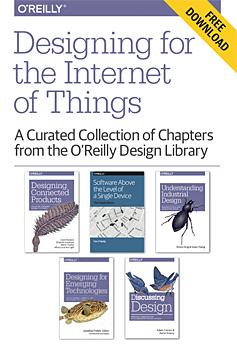Mary Treseler
Empathy: The designer’s superpower
Scott Jenson on empathy, interaction on demand, and Google’s Physical Web Project.
 I recently connected with veteran designer Scott Jenson, who is currently developing the Physical Web Project with the Chrome team at Google. We’ve been talking quite a bit about empathy in the past few months here at O’Reilly, and Scott’s recent blog post, The Paradox of Empathy, caught my attention. I sat down with him to learn more about his thinking around empathy and to talk about his work on the Physical Web Project.
I recently connected with veteran designer Scott Jenson, who is currently developing the Physical Web Project with the Chrome team at Google. We’ve been talking quite a bit about empathy in the past few months here at O’Reilly, and Scott’s recent blog post, The Paradox of Empathy, caught my attention. I sat down with him to learn more about his thinking around empathy and to talk about his work on the Physical Web Project.
Empathy is part of every great designer’s toolkit
Jenson is often asked for recommendations for learning the next tool, or program. but as he explains, learning how to empathize is fundamental to product design:
When I reflected on what I wanted people to understand, what the core thing was, it wasn’t a technique. It wasn’t a visual style. It wasn’t learning a certain program. The core thing was making sure that you never thought about the product from your point of view, but from somebody else’s point of view. That’s what prompted the [The Paradox of Empathy] post.
He breaks empathy down into four components:
I basically take the whole design process from soup to nuts and break it up into four types of things, what I called understanding, bridging, flowing, and refining, which is a little bit of wordplay, but it was just really trying to say that most people talk about the icons and the buttons. That’s the last category, the refining. What I tried to do was to go back in time to get earlier and earlier interactions with people. So, the flowing is basically just how the whole program feels and what metaphors do you use, and how many steps do they take. It’s the level above the bits. Bridging was about matching the technology to the actual user needs. The most important one, the one that we actually tried to do the most when I was at Frog Design, was understanding, which was just to understand what people were doing, what were they up to, where they were at. In fact, to the point where you’re not even designing a product for them. One of the reasons why I think [The Paradox of Empathy] post got some positive response, was the fact that the first two were so clearly focused on user research.
IBM is banking on design’s ROI
Phil Gilbert on IBM’s deep design roots, change management, and hiring for culture fit.
Companies of all sizes are recognizing that by taking a design-first approach to product development, they can improve profit. I recently sat down with Phil Gilbert, GM of design at IBM, to discuss how he is helping to lead the transformation to a design-first company within IBM. Adopting design as a key corporate asset may seem like a no-brainer, but for a company of more than 350,000 employees, it’s a massive undertaking. IBM hasn’t been quiet about its plans to hire 1,000 designers over the course of five years and embed design in product teams throughout the organization.
IBM’s long history of design
What I was surprised to find when reading about IBM’s latest design plans, is that the giant tech company has design roots dating back to the 1950s. Gilbert shares in more detail:
We started our first design program — and we were one of the first to really apply design holistically at scale — in 1956. In the 1950s and the 1960s and into the early 1970s, we had a constellation of designers around IBM that, quite frankly, has never been equaled.
Elliott Noyes was our first head of design. Thomas Watson Jr. hired him in 1956. He assembled people like Eero Saarinen, Charles and Ray Eames, and Paul Rand. He assembled this team of people, and, essentially, I think the reason it happened then is because humanity was addressing a fundamentally different relationship between ourselves and technology. There was a lot of turmoil and angst as a result. We used design at that time to communicate and engage in a conversation with humanity about that relationship and about our role with technology. We viewed it as a very holistic statement — we communicated it through our products, our communications, our buildings, and we did it through our exhibits at places like the World’s Fair.
Since then, I don’t think there has been as fundamental a change in the relationship between human beings and technology. The move from mainframe to mini-computer, the move from mini-computer to personal computer, the move to client-server computing — all of these things were actually fairly incremental. But I think in 2007, with the release of the iPhone and with the ubiquitous access via mobile devices, I actually think that we’re, again, in a time of real turmoil and change around this relationship of where does technology sit with human beings.
This is a real change, and I think that human-centered design and design thinking as a method to achieve human-centered design is why it’s become so important. Because our relationship with technology is, it may not be as frightening as it was in the 50s and 60s, but it certainly is fundamental. I don’t think we quite yet understand it. I think design is the primary lever that we have to understand that relationship and then to communicate that relationship.
6 best practices for giving a product critique
Productive critique can strengthen relationships and collaboration, improve productivity, and lead to better designs.
Download a free copy of Designing for the Internet of Things, a curated collection of chapters from the O’Reilly Design library. This post is an excerpt from Discussing Design, by Adam Connor and Aaron Irizarry, one of the books included in the curated collection.
There are two sides, or roles, in any critique:
Recipient: The individual(s) receiving the critique (i.e. the creator or presenter of whatever is being analyzed) who will take the perspectives and information raised during the critique, process it, and act upon it in some way.
Giver: The individual(s) giving the critique, who are being asked to think critically about the creation and provide their thoughts and perspectives.
Within both of these roles, there is the discrete aspect of intention: why are we asking for/receiving/giving feedback. Intent is the initiator of the conversation and is often what separates successful critiques and feedback discussions from problematic ones.
For the best discussions, the intent of each participant, regardless of whether they are receiving or giving critique, needs to be appropriate. If we aren’t careful, critique with the wrong, or inappropriate, intent on either side can lead to problems not only in our designs, but also in our ability to work with our teammates. Read more…
In design, what we really need is critical thinking
More than reaction or direction, critique is the key to understanding the impact of design decisions.
Download a free copy of Designing for the Internet of Things, a curated collection of chapters from the O’Reilly Design library. This post is an excerpt from Discussing Design, by Adam Connor and Aaron Irizarry, one of the books included in the curated collection.
One of the most common ways design discussions are initiated is for a team member to ask for feedback on something they’ve created or an idea they have. They might just grab someone at a nearby desk because they want to take a break from putting something together and think about what they’ve done so far. Or it could be part of a planned milestone or date in the project’s timeline, often called Design Reviews.
It’s not that either of these is a bad time to get other’s thoughts. Rather, the first real problem we encounter is from the word “feedback” itself. It’s a word that’s become engrained in our vocabulary. We use it all the time, a la “I’d love to get your feedback on something…”
What is feedback?
The issue with the term “feedback” lies in its broadness. Feedback itself is nothing more than a reaction or response. Designers talk about feedback and feedback loops all the time in their work. The user of a system or product interacts with it in some way, perhaps by clicking a button, and the system changes in one way or another. It could be that an animated loading bar appears while some new data is fetched and displayed, or maybe some elements in the interface move their position.That reaction by the system is the feedback. It is the system’s response to what the user has done. Feedback is a reaction that occurs as a result of us doing something. In human-to-human interactions, such as the conversations we have in our projects, feedback can be nothing more than a gut reaction to whatever is being presented. And to be quite honest, even though we might not want to admit it, that’s often all it is.
Read more…
The next big thing sits between tech’s push and consumers’ pull
Pilgrim Beart on AlertMe, and IoT’s challenges and promise.
I recently sat down with Pilgrim Beart, co-founder of AlertMe, which he recently sold to British Gas for $100 million. Beart is a computer engineer and founder of several startups, including his latest venture 1248.
Identifying the gap between technology and consumers: How AlertMe was founded
I asked Beart about the early thinking that led him and his co founder, Adrian Critchlow, to create AlertMe. The focus seems simple — identify user need. Beart explained:
I co-founded AlertMe with Adrian Critchlow. He was from more of a Web services background … My background was more embedded technology. Over a series of lunches in Cambridge where we both lived at the time, we just got to discussing two things, really. One was the way that technology was going. Technology push — what changes were happening that made certain things inevitable, and also consumer pull. What were the gaps that technology wasn’t really addressing?
To some extent we were discussing at quite a high level the intersection of those two, perhaps not quite in that rational way, but as we talked about things we were interested in, that’s essentially what we were doing. We were triangulating between the technology push and the consumer pull, and trying to spot things that essentially would be inevitable because of those two things. Then that led us to thinking about the connected home platform and what could the killer apps for the connected home be, and isn’t it strange how, if you compare the home to the car for example, cars have a large number of computers in them, and the computers all work together seamlessly and invisibly to keep you safe, keep you secure, save you energy, and so on.
In the home, you have a similar number of computers, but they’re not talking to each other, and as a result, it’s really far from ideal. You have no idea what’s going on in your home most of the time, and it’s not energy efficient, it’s not secure, etc. We saw a huge opportunity there, and we saw the potential for some technological advances to help address those problems.
Design’s role is to bridge context gaps
Andrew Hinton on making context understandable, smart devices, and programming literacy.
I sat down with Andrew Hinton, an information architect at The Understanding Group and author of the recently released O’Reilly book Understanding Context. Our conversation included a discussion of information architecture’s role in the context of the IoT, the complexities of context, and the well-debated “everyone should learn to code” argument.
Context, information architecture, and experience design
Information architecture (IA) has always been a critical part of creating great products and services, and many would argue that, until now, it hasn’t been given the attention or respect it deserves. The need for thoughtful IA is increasing as we enter the multimodal world of IoT. Whether you call yourself an Information Architect or Designer, you need to care about context. Hinton offers up this hidden motivation for writing Understanding Context:
“I’ll confess, the book is a bit of a Trojan horse to kind of get people to think about information architecture differently than maybe the way they assume they should think about it.”
I followed up with Hinton via email for a bit more on how we need to view IA:
“People tend to assume IA is mainly about arranging objects, the way we arrange cans in a cupboard or books in a library. That’s part of it, but the Internet has made it so that we co-exist in places made of semantic and digital information. So when we create or change the labels, relationships, and rules of those places, we change their environment. Not just on screens, but now outside of screens as well. And, to me, the central challenge of that work is making context understandable.”
Cross-device interactions and interusability
Designers need to create a coherent UX across all the devices with which a user interacts.
Editor’s note: This is an excerpt by Claire Rowland from our upcoming book Designing Connected Products. This excerpt is included in our curated collection of chapters from the O’Reilly Design library. Download a free copy of the Designing for the Internet of Things ebook here.
In systems where functionality and interactions are distributed across more than one device, it’s not enough to design individual UIs in isolation. Designers need to create a coherent UX across all the devices with which the user interacts. That means thinking about how UIs work together to create a coherent understanding of the overall system, and how the user may move between using different devices.
Cross-platform UX and usability
Many of the tools of UX design and HCI originate from a time when an interaction was usually a single user using a single device. This was almost always a desktop computer, which they’d be using to complete a work-like task, giving it more or less their full attention.The reality of our digital lives moved on from this long ago. Many of us own multiple Internet-capable devices, such as smartphones, tablets, and connected TVs, used for leisure as well as for work. They have different form factors; may be used in different contexts; and some of them come with specific sensing capabilities, such as mobile location.
Cross-platform UX is an area of huge interest to the practitioner community. But academic researchers have given little attention to defining the properties of good cross-platform UX. This has left a gap between practice and theory that needs addressing.
In industry practice, cross-platform UX has often proceeded device by device. Designers begin with a key reference device and subsequent interfaces are treated as adaptations. In the early days of smartphones, this reference device was often the desktop. In recent years, the “mobile first” approach has encouraged us to start with mobile Web or apps as a way to focus on optimizing key functionality and minimize “feature-itis.” Such services usually have overarching design guidelines spanning all platforms to ensure a degree of consistency. The aim is usually on making the different interfaces feel like a family, rather than on making the devices work together as a system. Read more…
The magic design sauce: curiosity and serendipity
Khoi Vinh on "How They Got There," the cards interaction model, and designers as founders.

I recently sat down with Khoi Vinh, vice president of user experience at Wildcard and co-founder of Kidpost. Previously, Vinh was co-founder and CEO of Mixel (acquired by Etsy, Inc.), design director of The New York Times Online, and co-founder of the design studio Behavior, LLC. Our conversation included a discussion of career paths; the much talked about new interaction model, cards; and advice for design entrepreneurs.
Curiosity serves designers well
Vinh and I discussed the ever-evolving role of designers. He recently self-published How They Got There, a book of interviews with interaction designers who describe their career paths and offer advice and insight. Vinh explained:
“How They Got There is kind of like the book I wish I could have read when I was just starting out in my career. The central thesis is that very few careers are truly planned out, A to B, to C, to Z, and it’s usually a lot of stuff that just happens by circumstance or blind luck, or through someone who knows someone.
“As I became more and more aware of that in my career, I started to find those stories really interesting, really revealing, because they say so much about the character of people who achieve notoriety in their careers; the circumstances that led them to where they are can be fascinating. In a lot of instances, the things that get these people onto these paths are very, very minor events or minor coincidences. … There’s a serendipity, but I think, one thing that comes out when you read these stories is what serves these designers really well is curiosity, a willingness to be available to opportunities, so to speak. They go with the flow. They let one thing turn into another through their ability to acclimate themselves to various situations.
“What’s that old saying from Branch Rickey — “luck is the residue of design”? These careers are somewhat serendipitous, but they are really the result of folks who are very conscientious about making the most of whatever situation they had and working really hard and applying themselves, and looking at the world around them with great curiosity and being really willing to study what it takes to get to the next level.”
Your product can’t break its promise
Consumers are more aware of connected devices, but they need to be convinced a product will do something valuable for them.
Editor’s note: This is an excerpt by Claire Rowland from our upcoming book Designing Connected Products. This excerpt is included in our curated collection of chapters from the O’Reilly Design library, Designing for the Internet of Things.
In 1962, the sociologist Everett Rogers introduced the idea of the technology lifecycle adoption curve, based on studies in agriculture. Rogers proposed that technologies are adopted in successive phases by different audience groups, based on a bell curve. This theory has gained wide traction in the technology industry. Successive thinkers have built upon it, such as the organizational consultant Geoffrey Moore in his book Crossing the Chasm.In Rogers’ model, the early market for a product is composed of innovators (or technology enthusiasts) and early adopters. These people are inherently interested in the technology and willing to invest a lot of effort in getting the product to work for them. Innovators, especially, might be willing to accept a product with flaws as long as it represents a significant or interesting new idea.
The next two groups — the early and late majority — represent the mainstream market. Early majority users might take a chance on a new product if they have seen it used successfully by others whom they know personally. Late majority users are skeptical and will adopt a product only after seeing that the majority of other people are already doing so. Both groups are primarily interested in what the product can do for them, unwilling to invest significant time or effort in getting it to work, and intolerant of flaws. Different individuals can be in different groups for different types of product. A consumer could be an early adopter of video game consoles, but a late majority customer for microwave ovens. Read more…
Designing the dynamic human-robot relationship
Scott Stropkay and Bill Hartman on human-robot interaction, choice architecture, and developing degrees of trust.
Jonathan Follett, editor of Designing for Emerging Technologies, recently sat down with Scott Stropkay, founding partner at Essential Design Service, and Bill Hartman, director of research at Essential Design Service, both of whom are also contributing authors for Designing for Emerging Technologies. Their conversation centers around the relationship dynamic between humans and robots, and they discuss ways that designers are being stretched in an interesting new direction.
Accepting human-robot relationships
Stropkay and Hartman discussed their work with telepresence robots. They shared the inherent challenges of introducing robots in a health care setting, but stressed that there’s tremendous opportunity for improving the health care experience:
“We think the challenges inherent in these kinds of scenarios are fascinating, how you get people to accept a robot in a relationship that you normally have with a person. Let’s say, a hospital setting — how do you develop acceptance from the team that’s not used to working with a robot as part of their functional team, how do you develop trust in those relationships, how do you engage people both practically and emotionally. How, as this scenario progresses, you bring robots into your home to monitor your recovery is one of the issues we’ve begun to address in our work.
“We’re pursuing other ideas in relations to using smart monitors, in the form of robot and robotic enhanced devices that can help you advance your improvement in behavior change over time … Ultimately, we’re thinking about some of the interesting science that’s happening with robots that you ingest that can learn about you and monitor you. There’s a world of fascinating issues about what you want to know, and how you might want to learn that, who gets access to this information, and how that interface could be designed.”
 Mary Treseler is Director of Strategic Content at O'Reilly Media, Inc. She acquires, curates, and edits design content, when not writing about it herself. Her experience with design-related topics includes editing "Lean UX" and "Designing Interfaces" as well as launching "The Lean Series" with Eric Ries. Mary has more than 20 years of experience working in technology publishing; her introduction to the design discipline began in 1993 with Jakob Nielsen's "Usability Engineering." A Boston native, Mary lives by the ocean in South Dartmouth, MA.
Mary Treseler is Director of Strategic Content at O'Reilly Media, Inc. She acquires, curates, and edits design content, when not writing about it herself. Her experience with design-related topics includes editing "Lean UX" and "Designing Interfaces" as well as launching "The Lean Series" with Eric Ries. Mary has more than 20 years of experience working in technology publishing; her introduction to the design discipline began in 1993 with Jakob Nielsen's "Usability Engineering." A Boston native, Mary lives by the ocean in South Dartmouth, MA.





